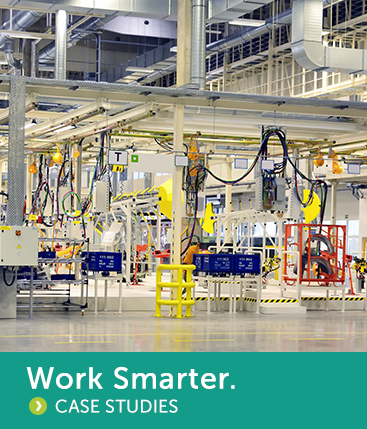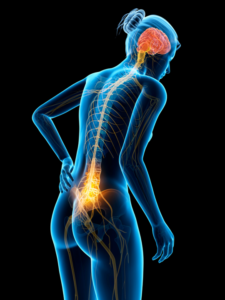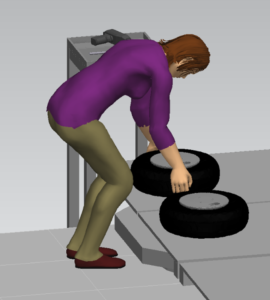Lean Manufacturing and Ergonomics may have different intents and purposes, but through teamwork and cooperative assessments, they can complement each other in making the workplace a more efficient and safer place.
Because Ergonomics and Lean originated in the manufacturing world at different times, they are not fully integrated – but they may soon be. Ergonomics is a fairly recent science that is growing quickly as an increasing number of companies and their corresponding industries take notice of its significance in reduction of injuries and in the end, reduction in cost.
To see why lean manufacturing and ergonomics don’t need to be oil and water, read the full article below.
—
Oil and Water?
Profitability seems like a simple concept; as long as a company’s total revenue outweighs its total expenses, said company gains financial benefit. Profit margins get larger in relation to the success of the company, which is due in large part to the emphasis on efficiency and productivity in the area of manufacturing.
Emphasis on productivity and efficiency was first implemented in the world of manufacturing by Henry Ford with the invention of the modern assembly line. Ford placed high importance on the elimination of waste and unnecessary cost in relation to the building of his vehicles.
Since then, other manufacturing companies adopted this style of business, and technology has only driven its perfection. Toyota is one of those companies that has perfected the idea of Lean Manufacturing and is now one of the leaders in elimination of “waste”.
Industrial ergonomics in contrast is a much younger science but is being embraced in manufacturing at an exponential rate. While the Lean principle concentrates on the interests and priorities of the business exclusively, while Ergonomics concentrates on the human by ensuring the job demands do not exceed the capabilities of the person.
By studying the Lean model as well as ergonomics, one can see the necessity of both practices in the industrial workplace, as well as observe that both can complement each other.
The major facet of the Japanese business model, “Lean,” is used to “create a streamlined, high quality system that produces finished products at the pace of customer demand with little or no waste” (Rachna Shah) during the manufacturing process.
The 7 types of waste to eliminate include:
- Overproduction
- Waiting [time on hand]
- Transportation or conveyance
- Over processing/ incorrect processing
- Excess inventory
- Unnecessary movement
- Defects
The above list includes what Toyota has “identified [as the] seven major types of non-value adding activities” (Jeffery K. Liker). These seven facets do not add any value to the product being made or the process being carried out and only hinder efficiency. It is essential to remove as much of this waste as possible for success, but working independent of ergonomics, Lean can potentially affect the health of the worker.
Certain things like waiting, transportation and unnecessary movement can be eliminated, but leaving a small amount of these features can actually be beneficial to an operator when looking at the body’s limitations.
When Lean is being implemented in a manufacturing setting, individuals may observe an operator is spending 20% of their cycle time performing the wasteful task of “waiting” and will add elements to their job. An operator in this situation could be at risk if there is no input from ergonomics, and receive too much work as an addition. Operators in the manufacturing industry need rest/recovery time because a task that “exceeds a worker’s normal energy capacities, [can] cause a premature decrease in strength and increase [in] the likelihood of injury” (Lehmann).
Transportation and unnecessary movement must also be looked at within context, as complete removal of them can have detrimental effects. Implementers of Lean can spot a few steps an operator takes during their standard work and deem them unnecessary and wasteful. They can also look at the layout of the materials needed by the operator and re-organize them to be around side the operator in order to decrease their reaching distance.
By eliminating these few steps, they reduce the amount of time needed to grasp a part, which slightly increase the efficiency of the operator as well as the productivity of how many parts per hour they can yield. However, ergonomics has shown by eliminating the stepping area, the operator no longer steps from one station to the next, but twists their body as a whole. This twisting motion creates a torque on the spine and increases the chance for injury as there is a “well documented link between occupational twisting and the increased incidence of lower back pain” (McGill).
Similar to operators who have parts brought closer to them, parts set up outside of an optimal work zone can cause an operator to execute an awkward postures in order to attain their part. There are instances where the majority of materials have been placed above the shoulder height in front, and to the side of the operator, then “increasing arm elevation [which] increases risk for impingement- related and rotator cuff injuries” (Lowe BD). Unnecessary shoulder flexion and abduction can be avoided by placing materials within optimal vertical and horizontal reach zones.
Due to the fact that Ergonomics and Lean originated in the manufacturing world at different times, they are not fully integrated. Ergonomics is a fairly recent science that is growing quickly as an increasing number of companies and their corresponding industries take notice of its significance in reduction of injuries and in the end, reduction in cost. These principles may have different intents and purposes, but through teamwork and cooperative assessments, they can complement each other in making the workplace a more efficient and safer place.
References
Jeffery K. Liker, David Meier. The Toyota Way Field Book. New York: McGraw Hill, 2006.
Lehmann, G. “Physiological Measurements as a basis of work organization in industry.” Ergonomics (1958): 328-344.
Lowe BD, Weir PL, Andrews DM. “Observation-Based Posture Assessment: Review of Current Practice and Recommendations for Improvement.” DHHD (NIOSH) Publication No. 2014-131 (2014): 1-19.
McGill, Stuart M. “Electromyographic Activity of the Abdominal and Low Back Musculature During the Generation of Isometric and Dynamic Axial Trunk Torque: Implications for Lumbar Mechanics.” Journal of Orthopedic Research(1991): 91-103.
Rachna Shah, Peter T. Ward. “Lean manufacturing: context, practice bundles and performance .” Journal of Operations Management (2003): 129-149.








 Why Sandalwood?
Why Sandalwood?


 We are a one-stop-shop for launching job rotation for any employer from conception to implementation. Our experts tailor our services to meet the needs of our customers by collaborating with them throughout the entire process. We do not offer cookie cutter solutions for job rotation because the needs of employers vary significantly.
We are a one-stop-shop for launching job rotation for any employer from conception to implementation. Our experts tailor our services to meet the needs of our customers by collaborating with them throughout the entire process. We do not offer cookie cutter solutions for job rotation because the needs of employers vary significantly. Why Sandalwood?
Why Sandalwood?



 Sandalwood is pleased to offer solutions above and beyond the traditional ergonomic assessments. With an in-depth knowledge of various digital human modelling software suites, integration and adoption to your health and safety programs has never been easier. Sandalwood is experienced in ergonomic program design as well as industry leaders in digital human modelling services. We have a diverse team that is able the leverage the results from the digital human model to provide in depth risk assessments of future designs and current state. Sandalwood is also able to pair these assessments with expertise and provide guidance on the best solution for you. Sandalwood is also on the forefront of emerging technologies and able to integrate Motion capture, Wearables, and extended or virtual reality into your ergonomic program.
Sandalwood is pleased to offer solutions above and beyond the traditional ergonomic assessments. With an in-depth knowledge of various digital human modelling software suites, integration and adoption to your health and safety programs has never been easier. Sandalwood is experienced in ergonomic program design as well as industry leaders in digital human modelling services. We have a diverse team that is able the leverage the results from the digital human model to provide in depth risk assessments of future designs and current state. Sandalwood is also able to pair these assessments with expertise and provide guidance on the best solution for you. Sandalwood is also on the forefront of emerging technologies and able to integrate Motion capture, Wearables, and extended or virtual reality into your ergonomic program.



